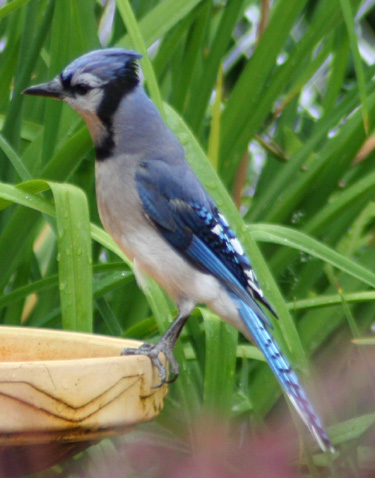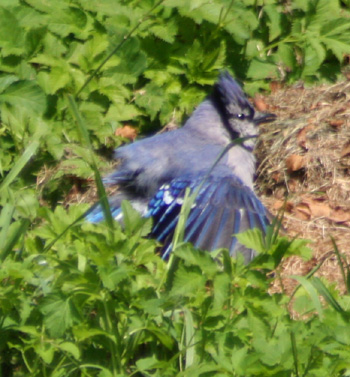Blue Jay – Cyanocitta cristata
General:
The Blue Jay (Cyanocitta cristata) is a North American jay, a bird with predominantly lavender-blue to mid-blue feathering from the top of the head to midway down the back. There is a pronounced crest on the head. The color changes to black, sky-blue and white barring on the wing primaries and the tail. The bird has an off-white underside, with a black collar around the neck and sides of the head and a white face.
head. The color changes to black, sky-blue and white barring on the wing primaries and the tail. The bird has an off-white underside, with a black collar around the neck and sides of the head and a white face.
Blue Jays reside over a very large area of the eastern side of North America from northeast Newfoundland to southeast Florida, western Texas and Midwestern United States, and north to central Alberta. It is mainly a bird of mixed woodland, including American beech and various oak species, but also of parks and gardens in some towns and cities. West of the Rockies, it is replaced
The voice is typical of most jays in being varied, but the most commonly recognized sound is the alarm call, which is a loud,  almost gull-like scream. There is also a high-pitched jayer-jayer call that increases in speed as the bird becomes more agitated. Blue Jays will use these calls to band together to drive a predator such as a hawk away from their nest.
almost gull-like scream. There is also a high-pitched jayer-jayer call that increases in speed as the bird becomes more agitated. Blue Jays will use these calls to band together to drive a predator such as a hawk away from their nest.
Blue Jays also have quiet, almost subliminal calls which they use among themselves in proximity. One of the most distinctive calls of this type is often referred to as the “rusty pump” owing to its squeaky resemblance to the sound of an old hand-operated water pump. In fact, they can make a large variety of sounds, and individuals may vary perceptibly in their calling style.
As with other blue-hued birds, the Blue Jay’s coloration is not derived by pigments, but is the result of light refraction due to the internal structure of the feathers; if a Blue Jay feather is crushed, the blue disappears as the structure is destroyed. This is referred to as structural coloration.
Identification Tips:
Blue jays are approximately 10 inches long with a black sturdy bill, blue crest and upper-parts, black eye line and breast band, grayish-white throat and underparts, bright blue wings with black bars and white patches. Typical blue jays have long blue tail with black bars and white corners. Their legs are dark.